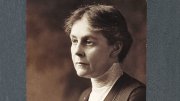When Alice Hamilton arrived at Harvard in 1919, the University had never admitted a woman to the faculty. Not everyone was happy she was there. Her male colleagues congratulated her with gritted smiles and asked her to confirm that she would not use the male-only Harvard Club or request football tickets. Under no circumstances was she to sit on the faculty platform at Commencement ceremonies.
She didn’t seem to take it personally. She saw her appointment as assistant professor in the new Department of Industrial Medicine as an opportunity to continue the groundbreaking work that would define her life. A pioneer in occupational health, she would spend decades campaigning against workplace toxins and dangerous industrial practices, long before “public health” was a common term. Ultimately, she became widely known for her unyielding crusade against tetraethyl lead (TEL), a gasoline additive that, she warned, risked poisoning generations.
Born in 1869 to a wealthy family in Fort Wayne, Indiana, Hamilton initially planned to become a missionary doctor. A course in bacteriology led her toward research; by 1897 she had earned her medical degree at the University of Michigan. Drawn to social reform, she applied to live in Chicago’s Hull House, a settlement house offering immigrants and the poor a chance to learn languages and new skills and receive basic healthcare. At Hull House she witnessed the effects of industrial accidents and toxin exposure on laborers. Her neighbors were factory workers who complained of headaches, tremors, and crippling fatigue that Hamilton resolved to investigate.
Her reputation took shape in 1910, when the state of Illinois asked her to study lead poisoning in local factories. She roamed factory floors with a doctor’s keen eye and a reformer’s passion, scribbling notes on poor ventilation, dusty workstations, and workers sporting the telltale bluish “lead line” on their gums. Hamilton’s investigations were among the first to show methodically that industrial-scale exposure to lead was a death sentence. She interviewed workers suffering seizures, blindness, and partial paralysis. In her final report, she labeled the effects of lead “insidious” and proposed stricter regulations.
By the early 1920s, her crusade against occupational poisons expanded to a new, alarming threat: tetraethyl lead. Introduced as an anti-knock additive to gasoline by General Motors and DuPont, TEL was hailed as a technological miracle. But Hamilton, who recalled what she had seen in Illinois, remained skeptical. She pored over reports of workers in New Jersey falling gravely ill—hallucinating, convulsing, and even dying. The engineer who invented leaded gasoline, Thomas Midgley Jr., and his boss, industrialist Charles Kettering, insisted TEL was safe when properly handled. She knew better.
Finally, in May 1925, at a government conference in Washington, D.C., to debate TEL’s safety, her anger boiled over. The men defending the compound, she warned, were courting disaster on a national scale. She accused Midgley and Kettering of negligence and, according to one eyewitness account, went so far as to call them “willful murderers.” Despite this confrontation, the conference concluded with no ban on TEL. Leaded gasoline became the norm, and people all over the country unknowingly breathed the poisonous metal from the tailpipe exhaust of millions of cars.
Although Hamilton never ceased her calls for stricter oversight, she found few allies in industry. She wrote articles in medical journals, lectured on the perils of heavy metals, and corresponded with reformers in other countries, all while facing business-sponsored criticism aimed at discrediting her expertise. Even so, the field of occupational health—largely shaped by her research—began to find its footing. She inspected factories and consulted with government bodies nationwide. Upon her retirement from Harvard in 1935, she left behind a program that had grown far beyond its modest beginnings.
In the end, her fight against lead outlived her. Hamilton died in 1970, just as the modern environmental movement was taking shape. Less than a decade later, a flurry of studies confirmed what she had known all along: TEL was accumulating in the environment, contaminating children’s bloodstreams, and causing untold neurological harm. By the 1980s, the United States began to phase out leaded gasoline. In 2021, the use of TEL in cars ended worldwide when the last country to use it, Algeria, used its final supply.
Hamilton’s broader legacy is unmistakable: modern occupational safety standards, the concept of industrial hygiene, and the insist- ence that workers have a right to safe conditions all trace back to her pioneering research. She also led the way for women in academic medicine. Her life is a reminder that the bravest voices are often those willing to speak inconvenient truths—despite powerful opposition.
Harvard never gave Hamilton a tenured professorship, but the evidence of her influence is everywhere—on factory floors, in public health policies, even in the air we breathe. She sought not fame but justice for laborers and a safer world for every person. Decades later, with leaded gasoline consigned to the past, it’s newly evident how prescient she was. Had she lived to see it, she would not have gloated; it wasn’t her way. But with a tight smile and pursed lips, she might have felt the satisfaction of having the last word.








